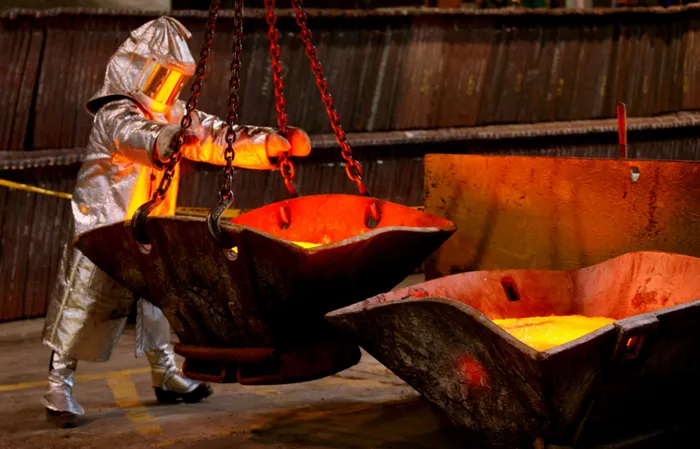Outlook for commodities: Three economists weigh in on a more muted short-term future

Commodity prices are moderating after a bullish run. Picture: File
Business Report interviewed three economists on their commodity outlook after bullish commodity prices earlier this year helped bolster South Africa’s gross domestic product.
They all pointed to a more muted picture ahead.
According to Anchor Capital investment analyst Seleho Tsatsi, the largest factor for commodity prices in the second half of 2022 will be the size of the stimulus coming out of China.
Certain commodities, particularly those deemed as important to the world's transition to a greener economy, had more attractive long-term demand outlooks. These are commodities like copper, zinc and nickel.
According to Tsatsi, other commodities like iron ore, also had much more muted long-term demand growth outlooks.
“Take copper, for instance, it seems easier to create a bullish medium-term scenario. For example, the copper market is roughly 28 million tons (annual demand), and the transition to a low-carbon economy is projected to be a strong and persistent addition to annual demand growth,” he said.
Tsatsi said new projects in the short-term were not expected to massively increase supply and lead times were pretty long. It seemed harder to make that case for iron ore returning to 2021 levels, which averaged $161(R2748) per ton last year, even with Chinese stimulus being expected.
He said platinum group metals (PGMs) were important commodities for South Africa.
Coming into 2022, Tsatsi said, expectations were for global car production to improve thanks to an easing of chip shortages.
“That thesis is looking less certain. Global car production has been decent, but rising inflation and interest rates are likely to put pressure on auto sales at some point if they continue," he said.
Tsatsi said thermal coal was gaining from a combination of supply disruptions from major producing regions like Indonesia, Australia, and South Africa and the impact of the ban on imports of Russian thermal coal into Europe.
“Prices have reached record levels, and while we do not expect them to hold there indefinitely, there is the potential for pricing to remain strong into the end of the year given the tightness we're seeing in energy markets,” he said.
Meanwhile, Umthombo Wealth Equity and ESG analyst Sandile Magagula said a combination of widespread quantitative easing programmes and supply shocks had driven commodity prices to record highs.
He said from 2020 peaks, it was not surprising that commodity prices had fallen 20 percent to 30 percent from the record highs, with the iron ore price having almost halved from a record high, on a combination of the easing supply chain, debt-laden property market, while a resolute US Federal Reserve committee’s ambition to rein in inflation had sent the dollar to a record 40-year high.
“This triggered a sell-off in the commodity market. Demand weakened as firms’ production of goods would be expensive, and that stubbornly high inflation would erode consumption rates giving rise to idle capacity and weaker demand outlook,” he said.
According to Magagula, traders dumped commodities with the fear of locking in profits. However, the sell-off was not broad-based as some commodities continued to benefit from geopolitical tensions.
“Energy, wheat, sunflower oil, and palladium are among the biggest beneficiaries of the ongoing war in Ukraine with Russia. These are highly liquid commodities with the established futures market, these factors cushioned overall performance of the commodity market in the face of waning demand and easing supply chain bottlenecks,” Magagula said.
He said higher commodity prices tend to benefit current account balances as demand for domestic currency often benefits from the high value of dollar earnings.
“Overall, the outlook for commodities is mixed considering increased geopolitical tensions. Luckily, South Africa (SA) has coal and palladium, thus the benefit to the trade balance will not be material given easing supply chain continue to unlock imports which were otherwise unable to reach SA shores," Magagula said
He said the rest of the commodities would continue to track weaker on a stronger dollar and slump in consumption because of falling demand. Firms were finding it uneconomical to invest and produce.
“This points to idle capacity and lower output growth, thus lower expenditure/consumption ... weaker demand should support a weaker commodity market,” he said.
Meanwhile, Investec's chief economist, Annabel Bishop, said food price inflation at the commodity level had continued to move lower, driven largely by grains, which was still expected to exert some downward pressure on producer price index (PPI) inflation figures in the third quarter of 2022, and so on consumer price index (CPI) inflation in particular in the fourth quarter of 2022 for South Africa.
“Falling food and energy prices since the end of the second quarter of 2022 have contributed to a moderation in commodity prices overall on the month, with gasoline prices down 15.2 percent and Brent crude oil -12.8 percent, and so large petrol, R2.72 per litre, and diesel at R2.48 per litre, price cuts are building for SA,” she said.
According to Bishop, fuel prices could be flattish to slightly lower in the third quarter of 2022 versus the second quarter of 2022, depending on the actual price changes at the pump, as fuel prices in SA remain state-administered prices.
“To date, August and July’s drop in petroleum product prices have overshadowed the rand weakness. However, it should be noted that fuel prices are still higher compared to a year ago, which will support inflation to some extent as the headline measure is based on year-on-year changes, and so a collapse in inflation is not likely, just a moderation over the second half of the year,” Bishop said.
She said lower international gasoline prices, if sustained, would have an impact on the likely outcome for SA’s CPI inflation rate for 2022, potentially moving it towards 6.6 percent year on year from a previous expectation of 6.9 percent year on year, if September saw the large fuel prices currently scheduled.
BUSINESS REPORT